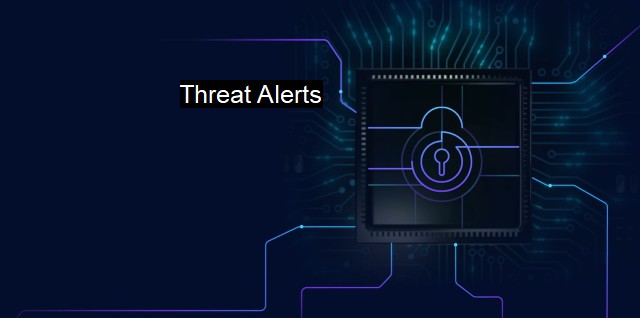What are Threat Alerts?
The Significance of Threat Alerts in Cybersecurity: Early Warning System to Identify and Mitigate Attacks
Threat alerts refer to notifications or alerts distributed by cybersecurity systems indicating the detection of potentially harmful intrusions or attacks in an information system or computer network. these signals act as deterrents by forewarning system administrators or users about a variety of possible threats that can sabotage their servers, devices, or digital information assets.Cybersecurity and antivirus solutions continuously monitor digital infrastructure to identify unusual activities and potential threats. When a cyber-threat is detected, the system activates an alert, otherwise known as a threat alert. The responsible party receives these threat alerts through different channels such as via email, SMS, in-app notifications, or sometimes directly on their system interfaces. Some advanced systems also provide the function of automated threat response alongside the alert.
Cybersecurity threat alerts coalesce a significant concern in a digitally-dependent dispensation that is continuously under the threat of cyber assault. The objective of such alerts is to identify, evaluate, and impede cyber threats before these threats can materially impact operations, damage systems, or compromise critical information. While threat alerts are typically part of a broader cybersecurity strategy, it's integral to realize they shouldn't be the sole reliance for a comprehensive safeguard.
Threats may range from low impact issues to complex cyber-attacks. They may be manifested in multiple forms including malware, data theft, phishing, spoofing, spyware, ransomware, or even sophisticated network-based attacks such as distributed denial-of-service (DDoS) attacks. It is the role of efficiently organized cybersecurity and antivirus systems to scrutinize these multiple varieties of cyber threats and communicate about these potential intrusions to the relevant parties through threat alerts.
It is important to note though that every alert does not mean there is a proven threat. Many cybersecurity solutions employ threat intelligence and machine learning algorithms to proactively detect anomalies and potential threats. sometimes these complexities may result in false positives - indicating a cyber threat alert when in fact there isn’t one. Nonetheless, false positives should not diminish the underlying importance of threat alerts in mitigating cybersecurity risks.
An efficient threat alert system will provide detailed information on the threat, its source, and potential impact. This communication aids users and system administrators in understanding just what they might be dealing with and what the subsequent steps should be in order to mitigate or annihilate the threat. Equally important are updates and modifications in antivirus and cybersecurity solutions to meet evolving threat landscapes and sophisticated technological advancements in malicious cyber behavior.
Response to threat alerts is usually stipulated by the cybersecurity strategy of an organization. In addition to proactive monitoring and threat alerting, this will typically encompass threat blocking, isolation of affected areas, and sometimes even auto-remediation whereby the software attempts to remove the detected threat.
As key as these alerts are in a cybersecurity architecture, the efficacy of threat alerts significantly hinges on the human element. No matter how advanced the antivirus or cybersecurity solution, if the end-user doesn't comprehend or respond appropriately to a threat alert, the risk of a successful cyber-attack heightens. Hence, both cybersecurity awareness and education fundamentally complement threat alert systems. Understanding what each threat signifies and how to tackle it should be integral to an organizations' or individuals' training routines.
Threat alerts form a vital cordon to alleviate potential cyber-spaces vulnerabilities. Through their timely tips, they forewarn users or administrators about aspects that need attention, enabling immediate action to be taken. In a world that is becoming increasingly digitally intertwined, and hence susceptible to cyber-attacks, the importance of an efficient and effective threat alert system cannot be understated. An alert today could foil a disastrous cyber-attack tomorrow.

Threat Alerts FAQs
What are threat alerts?
Threat alerts are notifications that are generated by cybersecurity software or antivirus programs. These alerts inform users of potential security threats or vulnerabilities that have been detected on their devices or networks.What types of security threats do threat alerts detect?
Threat alerts can detect a wide range of security threats, including viruses, malware, spyware, phishing attacks, and other types of cyberattacks. They can also detect vulnerabilities in software or operating systems that could be exploited by attackers.What should I do when I receive a threat alert?
When you receive a threat alert, it is important to take immediate action. You should follow the instructions provided in the alert to resolve the issue and protect your device or network from further harm. This may include running a malware scan, updating your antivirus software, or changing your passwords.How can I prevent receiving threat alerts in the future?
To prevent receiving threat alerts in the future, it is important to practice good cybersecurity habits. This includes keeping your operating system and software up to date, using strong and unique passwords, avoiding suspicious emails and links, and regularly backing up your data. You should also use reputable antivirus software and keep it up to date with the latest definitions and patches.| | A | | | B | | | C | | | D | | | E | | | F | | | G | | | H | | | I | | | J | | | K | | | L | | | M | |
| | N | | | O | | | P | | | Q | | | R | | | S | | | T | | | U | | | V | | | W | | | X | | | Y | | | Z | |
| | 1 | | | 2 | | | 3 | | | 4 | | | 7 | | | 8 | | |||||||